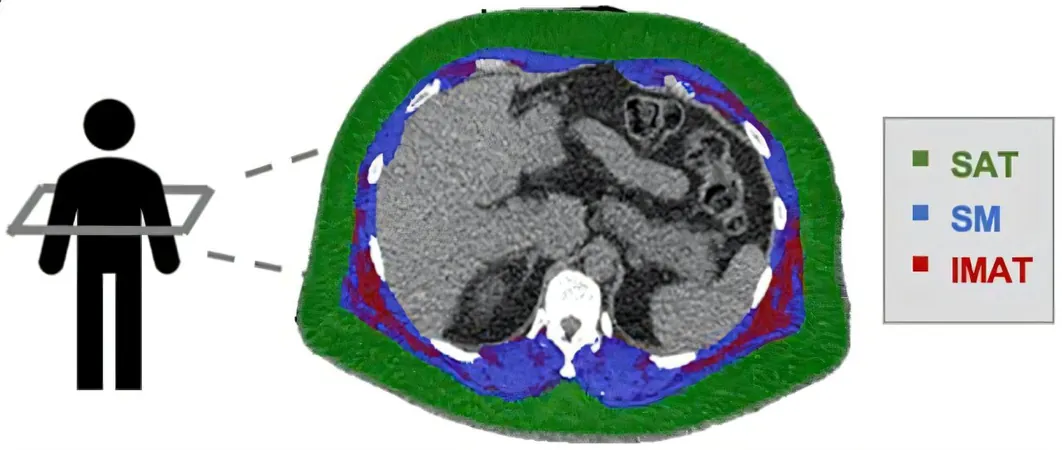
Hidden Fat in Muscles: A Silent Culprit Behind Heart Disease Risk
2025-01-20
Author: Ling
Introduction
A groundbreaking study published in the European Heart Journal reveals a startling connection between hidden fat within muscles and an increased risk of severe heart disease, independent of body weight. This newfound understanding challenges conventional health metrics like body mass index (BMI) that have long dictated how we assess obesity and its associated risks.
The Study and Its Findings
Led by Professor Viviany Taqueti from Brigham and Women's Hospital and Harvard Medical School, the research focuses on 'intermuscular' fat—fat stored in various muscles of the body. While often acknowledged for its culinary value in beef steaks, this form of fat has been largely overlooked in the context of human health. The study is the first to rigorously investigate its implications for cardiovascular health.
Professor Taqueti pointed out the gaps in our understanding of obesity's impact on heart health: “Obesity is a major global threat to cardiovascular health, yet BMI as a sole measure remains controversial and inadequate, particularly for women, where a higher BMI could indicate less harmful fat types.”
Research Methodology
The research examined 669 individuals aged about 63, primarily women, who sought medical attention for chest pain or shortness of breath. Importantly, none displayed evidence of obstructive coronary artery disease. Using advanced cardiac imaging techniques, researchers assessed both heart function and body composition, specifically focusing on the distribution of fat and muscle.
Risk Assessment of Intermuscular Fat
To quantify the risk stemming from intermuscular fat, the team calculated the 'fatty muscle fraction'—the ratio of intermuscular fat to total muscle and fat. The findings were alarming; a mere 1% increase in this fraction correlated with a 2% rise in the risk of coronary microvascular dysfunction and a staggering 7% increase in the likelihood of severe heart disease, irrespective of other risk factors, including BMI.
Impact on Health
Those exhibiting both high intermuscular fat and coronary microvascular dysfunction were found to be at an exceptionally high risk for adverse events such as heart failure and heart attacks. Conversely, individuals with more lean muscle mass had a reduced likelihood of these outcomes, while subcutaneous fat—fat located beneath the skin—did not carry as much risk.
Implications for Treatment
What’s particularly concerning is that the intermuscular fat may contribute to harmful inflammation and metabolic issues, potentially leading to insulin resistance and metabolic syndrome. Professor Taqueti noted, “Recognizing intermuscular fat as a significant risk factor for heart disease allows us to identify individuals at risk, regardless of traditional metrics like BMI. This could have meaningful implications in developing new treatment strategies.”
Future Directions
Current efforts are underway to assess how various therapeutic strategies—including exercise, dietary adjustments, and weight-loss medications—affect body composition and overall cardiovascular health. The research prompts critical questions regarding how we define and address obesity-related risks in clinical practice.
Further Research
Dr. Ranil de Silva from Imperial College London commented on the study's value, emphasizing its relevance in highlighting the complexities of obesity and cardiovascular health. He calls for further research to evaluate how markers like intermuscular fat can enhance our ability to stratify cardiac risk and tailor interventions accordingly.
Conclusion
As medical professionals and researchers continue to unravel the links between body composition and cardiovascular health, it’s essential for the public to reconsider how they view fat—especially that which resides within muscles. This study not only sheds light on an often-ignored aspect of health but also opens the door to new interventions that could save lives. Stay tuned for more updates on how this research may reshape our understanding of obesity and heart health!



 Brasil (PT)
Brasil (PT)
 Canada (EN)
Canada (EN)
 Chile (ES)
Chile (ES)
 Česko (CS)
Česko (CS)
 대한민국 (KO)
대한민국 (KO)
 España (ES)
España (ES)
 France (FR)
France (FR)
 Hong Kong (EN)
Hong Kong (EN)
 Italia (IT)
Italia (IT)
 日本 (JA)
日本 (JA)
 Magyarország (HU)
Magyarország (HU)
 Norge (NO)
Norge (NO)
 Polska (PL)
Polska (PL)
 Schweiz (DE)
Schweiz (DE)
 Singapore (EN)
Singapore (EN)
 Sverige (SV)
Sverige (SV)
 Suomi (FI)
Suomi (FI)
 Türkiye (TR)
Türkiye (TR)
 الإمارات العربية المتحدة (AR)
الإمارات العربية المتحدة (AR)